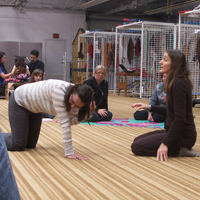9-Yr-Old Girl with ASD Significantly Decreases Self-stimulation Behaviors
Submitted by Jessica Rilee, OTD, OTR/L

|
Before
|
After
|
|
Often fixated on self-stimulation behaviors such as rocking back and forth, pressing into furniture with her hands, grinding teeth, and vocalizing high pitched sounds
|
Significantly decreased self-stimulation behaviors
|
|
Required verbal cues to complete daily self-care tasks and educational activities
|
Increased motivation and performance when completing daily living tasks more independently
|
CiCi is a 9-year-old girl with autism spectrum disorder who communicates primarily through gestures and minimal sign language for basic wants and needs. Throughout her daily routines for self-care and educational activities, she requires verbal cues to sequence each step of a task and often fixates on self-stimulation behaviors such as rocking back and forth, pressing into furniture with her hands, grinding her teeth, and vocalizing high pitched sounds.
Given her challenges with motivation to engage in daily routines and play activities, passive rhythmic movements and isometric reflex activities [from the Brain and Sensory Foundations course] were the most appropriate. Although she requires increased cues for some positions, such as side-lying and quadruped, she tolerates the passive rhythmic movements well and after 3 sessions began to slide on her own with stimulation from behind the knees in supine position. In some positions, she will sign to facilitator for more as a request to continue with the movement pattern after the first trial.
After experiencing the rhythmic movements and isometric activities, CiCi is described by her therapist and caregivers as more attentive, energetic, motivated to engage in her environment, smiling and laughing more often, as well as significantly decreased self-stimulation behaviors. Under most circumstances, unless she’s asleep, CiCi will continuously vocalize high pitched sounds, except during and briefly after rhythmic movements.
Now, in CiCi’s plan of care during therapeutic interventions and daily home routines, therapists and caregivers are able to use rhythmic movements and isometric activities [from the Brain and Sensory Foundations course] as a way to increase her motivation and performance for daily living skills such as dressing, hygiene, and self-grooming with more independence. Understanding how these rhythmic and isometric experiences affect the body and brain development provide a key to other ways we may be able to help individuals like CiCi who has similar experiences.
(Edited, emphasis added)


